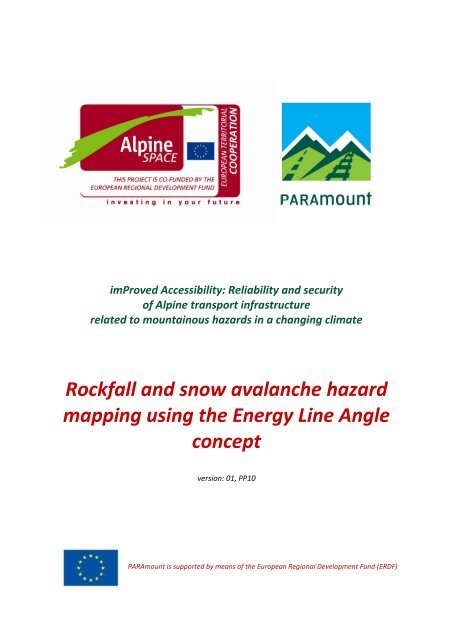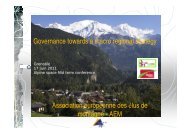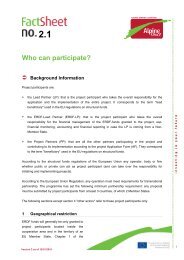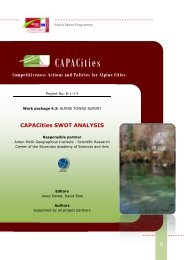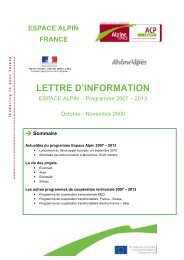Rockfall and snow avalanche hazard mapping using the Energy ...
Rockfall and snow avalanche hazard mapping using the Energy ...
Rockfall and snow avalanche hazard mapping using the Energy ...
You also want an ePaper? Increase the reach of your titles
YUMPU automatically turns print PDFs into web optimized ePapers that Google loves.
imProved Accessibility: Reliability <strong>and</strong> securityof Alpine transport infrastructurerelated to mountainous <strong>hazard</strong>s in a changing climate<strong>Rockfall</strong> <strong>and</strong> <strong>snow</strong> <strong>avalanche</strong> <strong>hazard</strong><strong>mapping</strong> <strong>using</strong> <strong>the</strong> <strong>Energy</strong> Line Angleconceptversion: 01, PP10PARAmount is supported by means of <strong>the</strong> European Regional Development Fund (ERDF)
1 The concept of <strong>the</strong> <strong>Energy</strong> Line AngleThe first step for elaborating an efficient risk prevention policy is to provide to experts <strong>and</strong> decisiontakers a clear <strong>and</strong> global vision of what could potentially happen in <strong>the</strong> territory that <strong>the</strong>y aremanaging. This territorial overview on geo <strong>hazard</strong>s potentialities can only be done at a global scalewhich is commonly <strong>the</strong> regional ones. With such information risk managers <strong>and</strong> decision takers areable to determine where local scale expertises are needed <strong>and</strong> to fix priorities in term of technicalinterventions <strong>and</strong> funds allocations.The general principle of <strong>hazard</strong> <strong>mapping</strong> procedure is 1) to determine <strong>the</strong> localisation of <strong>the</strong> <strong>hazard</strong>’spotential <strong>and</strong> active release areas, <strong>and</strong> 2) to estimate from <strong>the</strong>se release areas what are <strong>the</strong> maximalpossible run-out distances.Working at a regional scale means that modelling tools, for which high resolution data <strong>and</strong> fieldsurveys are needed, are not directly usable. Due to <strong>the</strong> resolution <strong>and</strong> <strong>the</strong> accuracy of <strong>the</strong> dataavailable at a regional scale, <strong>the</strong> use of process based 3d propagation models needs to aggregate <strong>and</strong>simplify <strong>the</strong> input parameters <strong>and</strong> so to deteriorate <strong>the</strong> domain of validity of <strong>the</strong> results obtainedwith such models. This kind of models is also time consuming <strong>and</strong> needs high storage numericalfacilities. So, for providing a robust <strong>and</strong> usable regional analysis <strong>the</strong> experts have to use modelsneeding <strong>the</strong> lowest amount of input data, data which should be easily available without specific fieldinvestigations. Probabilistic empirical models based on <strong>the</strong> analysis of past events database areclearly answering to <strong>the</strong>se needs.The advantage of such models is that for identifying potential release <strong>and</strong> propagation zones <strong>the</strong>y donot required any meteorological or geological data. Effectively <strong>the</strong>se models are only based ontopographic criteria <strong>and</strong> so <strong>the</strong> only input datum is a digital terrain model (DTM). Nowadays DTM areavailable for all <strong>the</strong> alpine space countries <strong>and</strong> so empirical models can be easily used for a first<strong>hazard</strong> geographical assessment <strong>and</strong> pre-<strong>mapping</strong>.Historically, <strong>the</strong> concept used for building up <strong>the</strong> first empirical model has been established by Heimin 1932 for rockfalls <strong>hazard</strong>. This concept is <strong>the</strong> one of <strong>the</strong> <strong>Energy</strong> Line Angle (ELA). This conceptstates that <strong>the</strong> maximal run out distance of a rockfall is corresponding to <strong>the</strong> point resulting of <strong>the</strong>graphical intersection between <strong>the</strong> horizontal plan <strong>and</strong> a virtual line (<strong>the</strong> energy line) starting at <strong>the</strong>release point <strong>and</strong> having a specific slope angle (). The following figure illustrates this concept.PARAmount page 2 of 57
Figure 1: The rockfalls <strong>Energy</strong> line Angle conceptHeim has also proved that <strong>the</strong> determination of <strong>the</strong> run out distance can be done <strong>using</strong> two differentangle of energy line. The calculation can be done 1) <strong>using</strong> <strong>the</strong> geometric angle which is calculated<strong>using</strong> <strong>the</strong> horizontal projection of <strong>the</strong> direct slope line between <strong>the</strong> release point <strong>and</strong> stopping one,or 2) <strong>using</strong> <strong>the</strong> travel angle which is calculated from <strong>the</strong> length of <strong>the</strong> horizontal projection of <strong>the</strong>line corresponding to <strong>the</strong> water flow direction along <strong>the</strong> slope. The travel angle is always flatter than<strong>the</strong> geometric ones, because <strong>the</strong> distance derived from <strong>the</strong> water flow direction is longer than <strong>the</strong>one calculated along <strong>the</strong> direct slope <strong>and</strong> so <strong>the</strong> ratio of height <strong>and</strong> horizontal length is smaller (cf.Fig.2).PARAmount page 3 of 57
Figure 2: The difference between <strong>the</strong> <strong>Energy</strong> Line geometric angle (in red) <strong>and</strong> <strong>the</strong> <strong>Energy</strong> Line travelangle (in blue).Since 1932 all <strong>the</strong> published field observations shows that <strong>the</strong> magnitude of <strong>the</strong> <strong>Energy</strong> Line Angle iswithin a certain range <strong>and</strong> above a certain limits with little variation (see below <strong>the</strong> chapter onrockfalls zoning). Therefore, it’s possible to get a realistic order of magnitude of <strong>the</strong> rockfalls run-outlength from a known release point.The <strong>Energy</strong> Line Angle concept of Heim has been adapted by Scheller in 1970 in order to calculate <strong>the</strong>maximal run out point <strong>using</strong> <strong>the</strong> foot of <strong>the</strong> cliff <strong>and</strong> not its top. This author has so defined <strong>the</strong>shadow angle (). The figure 3 presents <strong>the</strong>se two angles <strong>and</strong> <strong>the</strong> formula to be used for calculating<strong>the</strong> <strong>Energy</strong> Line Angle (<strong>the</strong> z has to be adapted for <strong>the</strong> calculation of <strong>the</strong> shadow angle). Meissl in1998 has determined that <strong>the</strong> difference between <strong>the</strong> geometric angle <strong>and</strong> <strong>the</strong> travel ones is lessthan 1 degree. The geometric angle is <strong>the</strong> easiest one to determine both in <strong>the</strong> field with aninclinometer or <strong>using</strong> a DTM.Figure 3: The difference between <strong>the</strong> <strong>Energy</strong> Line Angle () <strong>and</strong> <strong>the</strong> shadow ones ().PARAmount page 4 of 57
Dorren <strong>and</strong> Berger (2003) have confirmed <strong>the</strong> possibility of estimating <strong>the</strong> maximal speed of a rock<strong>using</strong> <strong>the</strong> maximal difference of altitude between <strong>the</strong> energy line angle <strong>and</strong> <strong>the</strong> slope profile (cf. Fig.4).Figure 4: How to determine <strong>the</strong> maximal speed of a rock <strong>using</strong> <strong>the</strong> <strong>Energy</strong> line Angle.The <strong>Energy</strong> Line Angle concept is perfectly adapted to a regional scale assessment if a past rockfallsevents data base is available. For each past event <strong>the</strong> energy line angle can be calculated <strong>and</strong> so astatistical model can be calibrated.This simple concept based on <strong>the</strong> principle of <strong>the</strong> friction angle has been also tested for predicting<strong>snow</strong> <strong>avalanche</strong> maximal run out distance. The first author who has transposed this concept to <strong>snow</strong><strong>avalanche</strong> problematic is Körner in 1976. In 1979 Lied has proposed, for <strong>the</strong> Norway topographicconditions, <strong>the</strong> first <strong>snow</strong> <strong>avalanche</strong> maximal run out distance predictive model derived from <strong>the</strong>energy line angle concept of Heim. Since <strong>the</strong>n, <strong>the</strong> protocol used by this author for building up hismodel is <strong>the</strong> international reference for calibrating <strong>snow</strong> <strong>avalanche</strong> maximal run out distanceempirical models. This protocol is presented in <strong>the</strong> next chapter. As for rockfalls <strong>the</strong> calibration ofenergy line <strong>snow</strong> <strong>avalanche</strong> model needs a paste event data base for building up <strong>the</strong> statistical law tobe used.The simplicity of <strong>the</strong> ELA concept <strong>and</strong> <strong>the</strong> fact that <strong>the</strong> statistical laws used by <strong>the</strong> ELA models arecalibrated <strong>using</strong> past events data, make that <strong>the</strong> resulting <strong>hazard</strong> <strong>mapping</strong> allowed risk managers tohave a first rough <strong>and</strong> quick preliminary estimation of potential run out distances <strong>and</strong> to determinegeographical sectors for which local scale expertises have to be performed. Mapping <strong>using</strong> <strong>the</strong> ELAconcept can be very quickly provided <strong>using</strong> terrain <strong>and</strong> grid calculation modulus of GIS tools.PARAmount page 5 of 57
Within <strong>the</strong> Paramount project, <strong>the</strong> French partner IRSTEA has developed two regional scale modelsbased on <strong>the</strong> ELA concept, <strong>the</strong> first one Avalfor LIN is dedicated to <strong>snow</strong> <strong>avalanche</strong> <strong>hazard</strong> <strong>mapping</strong><strong>and</strong> <strong>the</strong> second one Rockfor LIN to rockfalls <strong>hazard</strong> <strong>mapping</strong>. These models, if <strong>the</strong>y are able to display<strong>the</strong> geographical areas potentially affected by <strong>the</strong>se <strong>hazard</strong>s, are also providing (if <strong>the</strong> forest map isavailable for <strong>the</strong> concerned study area) <strong>the</strong> zoning of <strong>the</strong> forest areas having a potential protectionagainst <strong>the</strong>se two natural <strong>hazard</strong>s. As <strong>the</strong>se models are dedicated to a regional scale <strong>mapping</strong>, <strong>the</strong>ycan be <strong>the</strong>n used both for risk prevention <strong>and</strong> forest management strategic planning. The two mainobjectives of <strong>the</strong>se models are to identify in a study area if human infrastructures are potentiallyendangered <strong>and</strong> if forest st<strong>and</strong>s located above <strong>the</strong>se infrastructure can provide a protective function.The general principle for this <strong>mapping</strong> is based on answering to <strong>the</strong> following questions:1. Where are <strong>the</strong> release areas?2. What is <strong>the</strong> maximum propagation area envelope?3. Is any human infrastructure located in <strong>the</strong> propagation area <strong>and</strong> if so, is it endangered?4. Are any forest st<strong>and</strong>s located in <strong>the</strong> release area <strong>and</strong>/or in <strong>the</strong> propagation area above <strong>the</strong>human infrastructure endangered?If <strong>the</strong> answer to <strong>the</strong> third question is yes, <strong>the</strong>n a specific expertise has to be conducted in order toassess <strong>the</strong> need of protective works. If <strong>the</strong> answer to <strong>the</strong> fourth question is yes, <strong>the</strong>n <strong>the</strong>se forestst<strong>and</strong>s serve a protective function, <strong>and</strong> an investigation at a local scale is needed in order to qualify<strong>and</strong>/or quantify <strong>the</strong> efficiency of this protection.PARAmount page 6 of 57
Flow chart 1 : The general flow chart of Rockfor LINDepending on <strong>the</strong> objectives, <strong>the</strong> input data needed are:PARAmount page 8 of 57
ObjectivesRelease zones <strong>mapping</strong>Run-out zones <strong>mapping</strong>Risk <strong>mapping</strong>Protection forest <strong>mapping</strong>Input data : raster maps (<strong>the</strong> resolutions can be different but <strong>the</strong>minimal resolution is <strong>the</strong> one of <strong>the</strong> DTM)DTMPast eventcadastres or anygeo-localizedinformationHumaninfrastructuresForest mapTable 1: The input data need for <strong>using</strong> Rockfor LINThe following maps illustrate <strong>the</strong> 3 main input data.Map 1: The 25x25m resolution DTM of <strong>the</strong> French case study “département des Hautes-Alpes” (5549km2)PARAmount page 9 of 57
Map 2: The map of <strong>the</strong> issues of <strong>the</strong> French case study “ département des Hautes-Alpes”PARAmount page 10 of 57
Map 3: The forest map of <strong>the</strong> French case study “ département des Hautes-Alpes”2.1 <strong>Rockfall</strong>s release areas <strong>mapping</strong> with Rockfor LINRockfor LIN can only be used if all potential rockfalls release points have been mapped. This <strong>mapping</strong>can be done via field surveys, aerial photography analysis, past events data base analysis ornumerical processing on <strong>the</strong> DTM. Rockfor LIN offers <strong>the</strong> possibility to perform a DTM analysis foridentifying rockfalls potential release areas.The assumption which has been used is that <strong>the</strong> release areas depend only on <strong>the</strong> topographicconditions of <strong>the</strong> case study. So, a simple slope threshold can be applied to <strong>the</strong> slope surface raster(computed from <strong>the</strong> raster Digital Terrain Model [DTM]). The resolution <strong>and</strong> <strong>the</strong> accuracy of <strong>the</strong> DTMaffect <strong>the</strong> results. At least a DTM resolution of 25x25m is necessary. According to <strong>the</strong> results ofDorren <strong>and</strong> Berger (2003), <strong>the</strong> equation used in Rockfor LIN is:α = 55 x RES -0.075 , where RES is <strong>the</strong> DTM resolutionAll cells with values higher than <strong>the</strong> threshold α are qualified as potential release zones for rockfalls.This equation has been established <strong>using</strong> a multi-resolution analysis of slope gradient in knownexisting rockfalls source area in five sites: France (1), Austria (2), Switzerl<strong>and</strong> (1) <strong>and</strong> Lichtenstein (1).The table below gives <strong>the</strong> threshold values for determining rockfalls release area for DTM mainresolutions.DTM resolution/cell size [m]Threshold slope gradient[°]1 555 4910 4625 43Table 2: Threshold values for determining rockfalls release area for DTMs’ main resolutionsWithin Rockfor LIN <strong>the</strong> user has to enter <strong>the</strong> DTM’s resolution <strong>and</strong> <strong>the</strong>n 1) <strong>the</strong> slope threshold isautomatically calculated <strong>and</strong> 2) <strong>the</strong> potential rockfalls release areas map is automatically produced. If<strong>the</strong> user wants to work with ano<strong>the</strong>r slope threshold value this is possible <strong>and</strong> he has to enter <strong>the</strong>value he wants to work with. It’s important to keep in mind that <strong>the</strong> slope threshold value calculation<strong>using</strong> a DTM could generates local errors <strong>and</strong> that this way of calculation can only determine releaseareas with a minimal height. So <strong>the</strong> resulting map has to be validated by local experts.PARAmount page 11 of 57
Effectively in a DTM <strong>the</strong> real curvature of a slope is expressed by <strong>the</strong> slope value of <strong>the</strong> cells. Forexample a slope of 43° in a 25x25m DTM can represent very different curvatures profiles asexpressed in <strong>the</strong> figure below:Figure 6: Example of variation of release area configuration expressed with a slope threshold of 43°.So in one cell <strong>the</strong> potential release vertical height is depending on: <strong>the</strong> value () <strong>and</strong> <strong>the</strong> length (valuemax = <strong>the</strong> DTM resolution) of <strong>the</strong> slope below <strong>the</strong> foot of <strong>the</strong> release area <strong>and</strong>, on <strong>the</strong> value of <strong>the</strong>slope angle threshold () used (cf. Fig.7).Figure 7: The parameters influencing <strong>the</strong> potential release vertical height.The table below gives for 1x1, 10x10 <strong>and</strong> 25x25m DTMs’ resolutions <strong>the</strong> potential Vertical ReleaseHeight (VRH) with ≤ <strong>and</strong> slope length = DTM resolution.PARAmount page 12 of 57
DTMResolution Slope threshold : [°][m]1,00 55,00Slope : [°]Vertical release height : VRH[m]0 1,435 1,3410 1,2515 1,1620 1,0625 0,9630 0,8535 0,7340 0,5945 0,4350 0,2455 0,00DTMResolution Slope threshold [°][m]10,00 46,28Slope : [°]Vertical release height : VRH[m]0 10,465 9,5810 8,6915 7,7820 6,8225 5,7930 4,6835 3,4540 2,0645 0,4646,28 0,00DTMResolution Slope threshold [°][m]25,00 43,20Slope : [°]Vertical release height : VRH[m]0 23,485 21,2910 19,0715 16,7820 14,3825 11,8230 9,0535 5,9740 2,5043,2 0,00Table 3 : Value of <strong>the</strong> potential Vertical Release Height for 1x1, 10x10 <strong>and</strong> 25x25m DTMs’ resolutionswith ≤ <strong>and</strong> slope length = DTM resolution.The use of <strong>the</strong> angle threshold is perfectly well adapted for identifying vertical release height of:≥23.5m in a DTM having a resolution of 25x25m, ≥10.5m in a DTM having a resolution of 10x10m,≥1.5m in a DTM having a resolution of 1x1m. These values are delimitating <strong>the</strong> domain of validity ofthis method. For lowest DTM resolutions than 1m, <strong>the</strong> slope gradient release areas method allows<strong>the</strong> expert to obtain a pre-map which will identify all <strong>the</strong> potential release area having a verticalheight at minima equal to <strong>the</strong> DTM resolution. So <strong>the</strong> expert has to check <strong>the</strong> validity of this pre-mapfor release area having a vertical height lowest than <strong>the</strong> DTM resolution. One solution is to use alowest angle threshold. In this case some “false” release area can be detected <strong>and</strong> <strong>the</strong> validation of<strong>the</strong> pre-<strong>mapping</strong> by <strong>the</strong> expert is obligatory. This validation can be done by sampling check point in<strong>the</strong> field.The following map illustrates <strong>the</strong> results obtained with this method in <strong>the</strong> French case study of <strong>the</strong>Paramount project.PARAmount page 13 of 57
Map 4: Map of rockfalls release zones obtained with Rockfor LIN (French case study “ département desHautes-Alpes”)2.2 <strong>Rockfall</strong>s potential maximal run-out areas <strong>mapping</strong> with Rockfor LINFrom each of <strong>the</strong> identified potential release areas, RockFor LIN simulates <strong>the</strong> maximal probablepropagation envelopes. For performing this calculation RockFor LIN uses based on <strong>the</strong> <strong>Energy</strong> Lineprinciple (Heim, 1932), <strong>and</strong> on <strong>the</strong> use of a lateral spread off angle. The lateral spread off angle isused for characterized <strong>the</strong> potentiality of lateral deviation of a rock along <strong>the</strong> most probabletrajectory path. The value of this angle has been fixed, <strong>using</strong> literature data (Dorren <strong>and</strong> Berger 2003,Jaboyedoff <strong>and</strong> Labiouse 2011), to 20°.Concerning <strong>the</strong> chose of value of <strong>the</strong> <strong>Energy</strong> Line Angle, <strong>the</strong> same approach based on a state of <strong>the</strong>art has been initially used. The table below gives <strong>the</strong> available value in <strong>the</strong> literature of <strong>the</strong> <strong>Energy</strong>Line Angle.Author/Source<strong>Energy</strong> Line AngleBetween brackets <strong>the</strong> value for <strong>the</strong> geometrical angleMinimum or interval ofvaluesAverage valuePARAmount page 14 of 57
Shreve (1968) (26.57° - 38.66°) ---Hsü (1975) 31° (32°) ---Onofri & C<strong>and</strong>ian (1979)Grunder ( 1984)Moser (1986)28.34° – 40.73°(28,84 ° - 41,73°)32.6° - 33.4°(33.1° - 34.4°)33° - 42°(34° - 43°)Domaas(1985 in Toppe 1987) 32° (33°) ---Mac ewen (1989) (30.96°) ≈ (31°)Gerber (1994)Meissl (1998)Heinimann et al. (1998)Focardi & lotti (2001)33°- 37°(33.5° - 38°)29° – 47,5°(29.5°- 48.5°)33° - 37°(33.5° - 38°)27° - 29°(27.5° - 30°)------------38° (38°)Ayala-carcedo et al. (2001) (29.1° - 38.9°) (31,9°)Jaboyedoff & Labouise (2003) 32° (33°) ---Jaboyedoff & Labouise (2011) (32,6° - 35,6°) 34°Corominas et al. (2003)Dorren & Berger (2005,2006)26° - 54°(27° 55°)31.3° - 37°(31.9° - 38 °)Copons et al.(2009) site a (36.87° - 56,3°) ---Copons et al.(2009) site b (28.81° - 42.0°) ---Hutter et al. (2005) reduce scaleexperiments------------(30° - 37°) ---Scheidegger (1973) (29.68° - 39,69°) ---Marquinez et al. (2002) site 1 (32.5° - 40.9°)Marquinez et al. (2002) site 2 (29.4° -38.5°)Antoniou & Lekkas (2009) (35°) ---Deparis et al (2008) (31,61° - 47,20°) ---(31.5° - 40.2°)PARAmount page 15 of 57
Hyndman & Hyndman (2009) (33°) ---Berger et al. (2009) with forest (27.67° - 33.88°) ---Berger et al. (2009) without forest (31.32° - 37.86°) ---Berger et al. (2009) reduce scaleexperiments(32.57° - 48.99°) ---Table 4: State of <strong>the</strong> Art on <strong>the</strong> <strong>Energy</strong> Line Angle valuesA statistical analysis has been performed on <strong>the</strong> data of <strong>the</strong> table 4, <strong>the</strong> table 5 presents <strong>the</strong> resultsof this analysis.StatisticsMinimal GeometricalAngleMaximal GeometricalAngleMean 31.14° 39.30°Min 26.57° 30°1 st quartile 29.45° 36,97°2 nd quartile 31.61° 38.583 rd quartile 33° 41.80°Max 36.87° 48.99°Table 5: Statistical distribution of <strong>the</strong> published minimal <strong>and</strong> maximal geometrical <strong>Energy</strong> LineAngleIn parallel to this State of <strong>the</strong> Art, <strong>the</strong> French Nor<strong>the</strong>rn Alps rockfalls data base has been used for astatistical analysis of <strong>the</strong> observed values’ distribution (cf. tab.6). <strong>the</strong> geometrical <strong>Energy</strong> Line Angleis surveyed since 2010 <strong>and</strong> for each event occurring in <strong>the</strong> French Nor<strong>the</strong>rn Alps <strong>and</strong> for which a fieldsurvey has been done. .StatisticsVolume(m 3 )<strong>Energy</strong> LineAngle (°)Centile<strong>Energy</strong> LineAngle (°)Centile<strong>Energy</strong> LineAngle (°)Minimum 0.02 24.65 0.001% 24.65 4.00% 28.00Maximum 200.00 58.42 4.00% 28.00 20.00% 32.00MeanvalueSt<strong>and</strong>arddeviation6.46 36.69 9.00% 30.00 40.00% 35.0018.88 5.54 35.00% 34.00 65.00% 38.00Median 1.50 36,00Total 194PARAmount page 16 of 57
number ofeventsTable 6: Results of <strong>the</strong> statistical analysis on <strong>the</strong> geometrical ELA in <strong>the</strong> French Nor<strong>the</strong>rn Alpsrockfalls data baseAll <strong>the</strong>se data have been used for defining a matrix of rockfalls propagation probabilities dependingon <strong>the</strong> value of <strong>the</strong> geometrical <strong>Energy</strong> Line Angle (β). This matrix, given below, is <strong>the</strong> one usedwithin RockFor LIN for run-out zone calculation.Geometrical <strong>Energy</strong> LineAngle thresholdsProbability of rockfallspropagation≥ 38°High35°≤
Map 5 : <strong>Rockfall</strong>s probable propagation zones map obtained with RockFor LIN ,<strong>and</strong> <strong>using</strong> a 25x25mDTM, for <strong>the</strong> French case study “ département des Hautes-Alpes”.PARAmount page 18 of 57
a) b)Map 6 : a) Probable rockfalls propagation zones (in orange, in red <strong>the</strong> release areas) determined withan ELA of 32° <strong>and</strong> <strong>using</strong> a 25x25m DTM for <strong>the</strong> Queyras area (zoom of <strong>the</strong> map at <strong>the</strong> scale of <strong>the</strong>“département des Hautes-Alpes”- b) Probable rockfalls propagation zones (in orange, in red <strong>the</strong>release areas) determined with an ELA of 38° <strong>and</strong> <strong>using</strong> a 25x25m DTM for <strong>the</strong> Queyras area (zoomof <strong>the</strong> map at <strong>the</strong> scale of <strong>the</strong> “departement des Hautes-Alpes”.PARAmount page 19 of 57
Map 7: Probable rockfalls propagation zones including <strong>the</strong> probable reaching frequency (in red <strong>the</strong>release areas) determined with an ELA of 32° <strong>and</strong> <strong>using</strong> a 1x1m LiDAR DTM for Forte buso case study(Italy).Map 8: Probable rockfalls propagation zones including <strong>the</strong> probable reaching frequency (in red <strong>the</strong>release areas) determined with an ELA of 38° <strong>and</strong> <strong>using</strong> a 1x1m LiDAR DTM for Forte buso case study(Italy).PARAmount page 20 of 57
Map 9: Probable rockfalls propagation zones including <strong>the</strong> probable reaching frequency (in red <strong>the</strong>release areas) determined with an ELA of 38° <strong>and</strong> <strong>using</strong> a 20x20m DTM for Tognazza Cavallazza casestudy (Italy).Map 10: Probable rockfalls propagation zones including <strong>the</strong> probable reaching frequency (in red <strong>the</strong>release areas) determined with an ELA of 32° for <strong>the</strong> Austrian case study.PARAmount page 21 of 57
Map 11: Probable rockfalls propagation zones including <strong>the</strong> probable reaching frequency (in red <strong>the</strong>release areas) determined with an ELA of 32° for Baca case study (Slovenia).2.4 Validation of Rockfor LINThe model RockFor LIN has been validated <strong>using</strong> 20 well documented past events. Each time <strong>the</strong>maximal run-out distance is at least included in <strong>the</strong> 32° ELA. The example below is <strong>the</strong> one of SaintPaul de Varces in France. In this district a rockfalls happened <strong>the</strong> 28 th December 2008. The observedtrajectories fit with <strong>the</strong> 38° ELA propagation zone (<strong>the</strong> versant is forested). RockFor LIN has been ableto identify <strong>the</strong> release area (circle in yellow on <strong>the</strong> map <strong>and</strong> <strong>the</strong> photo) <strong>and</strong> <strong>the</strong> maximal run-outpoint (green circle on <strong>the</strong> map <strong>and</strong> <strong>the</strong> photo).PARAmount page 22 of 57
Map 12: An example of validation of <strong>the</strong> results obtained with RockFor LIN , <strong>the</strong> event of <strong>the</strong>28/12/2008 in <strong>the</strong> district of saint Paul de Varces in France.This is very important to remind to <strong>the</strong> users that <strong>the</strong> results obtained with RockFor LIN have always tobe compare to <strong>the</strong> known events in <strong>the</strong> case study. If <strong>the</strong> observed run-out distances are length than<strong>the</strong> one calculates with RockFor LIN <strong>the</strong>n <strong>the</strong> value of <strong>the</strong> ELA has to be adapted.2.5 <strong>Rockfall</strong>s risk <strong>mapping</strong> with Rockfor LINThe last step of a risk <strong>mapping</strong> is to determine if socio-economic issues are endangered by <strong>the</strong>natural <strong>hazard</strong> studied. Good information on <strong>the</strong> location of facilities is <strong>the</strong>n required. At a regionalscale, each of <strong>the</strong> Alpine Space countries can find this information in <strong>the</strong> geographic database of <strong>the</strong>irrespective national geographic institutes.Usually <strong>the</strong>se databases list <strong>and</strong> correspondently map all human infrastructures: public facilities,dwellings, industries, as well as communication, electrical, gas <strong>and</strong> water infrastructure, etc.According to <strong>the</strong>ir importance or <strong>the</strong>ir extent, all <strong>the</strong>se items can be classified into protection prioritylevels. This ranking is not obligatory, but facilitates <strong>the</strong> definition of priority levels for specificprotection actions depending firstly on <strong>the</strong> importance of <strong>the</strong> issues <strong>and</strong> secondly on <strong>the</strong> <strong>hazard</strong>’sPARAmount page 23 of 57
specifications. This ranking is required to be performed jointly with all actors involved in riskprevention policy of <strong>the</strong> study area.By combining this map with <strong>the</strong> rockfalls run-out envelope map, <strong>the</strong> potentially endangeredinfrastructure can be identified by selecting all <strong>the</strong> items located between release points <strong>and</strong> run-outenvelopes. The map obtained includes <strong>the</strong> endangered issues <strong>and</strong> <strong>the</strong> associated release <strong>and</strong> run-outzones.If <strong>the</strong> “issues” map is available <strong>the</strong>n RockFor LIN performs automatically this analysis by maps crossing.The following maps illustrate different way of presenting <strong>the</strong> results of this risk analysis.a) b)Map 13 : a) Probable rockfalls 32° ELA propagation zones (in orange) <strong>and</strong> human infrastructureslocalization for <strong>the</strong> Queyras area (zoom of <strong>the</strong> map at <strong>the</strong> scale of <strong>the</strong> “département des Hautes-Alpes”- b) Probable rockfalls 38° ELA propagation zones (in orange) <strong>and</strong> human infrastructureslocalization for <strong>the</strong> Queyras area (zoom of <strong>the</strong> map at <strong>the</strong> scale of <strong>the</strong> “département des Hautes-Alpes”.PARAmount page 24 of 57
a) b)c)Map 14 :Illustration of <strong>the</strong> identification of endangered issues <strong>using</strong> <strong>the</strong> rockfalls propagation mapprovided by RockFor LIN for <strong>the</strong> case study Mittewald in Italy a) 1x1m LiDAR DTM ;b) <strong>the</strong> 32° ELArockfalls propagation zone including <strong>the</strong> reaching probability; c) identification of <strong>the</strong> sections of <strong>the</strong>road endangered <strong>and</strong> risk ranking <strong>using</strong> <strong>the</strong> reaching probability : section in black = high level of risk,section in dark grey = medium level of risk, section in soft grey = low level of risk, no colour = no riskPARAmount page 25 of 57
Map 15: Probable rockfalls propagation zones including <strong>the</strong> probable reaching frequency (in red <strong>the</strong>release areas) determined with an ELA of 32° <strong>and</strong> localization of <strong>the</strong> railway for Podbrdo case study(Slovenia).2.4 <strong>Rockfall</strong>s protection forest <strong>mapping</strong> with Rockfor LINThe protection forest <strong>mapping</strong> is <strong>the</strong> last step of <strong>the</strong> risk analysis than can be done with RockFor LIN .The general principle is to cross <strong>the</strong> map of endangered issues with <strong>the</strong> map of <strong>the</strong> geographicalextension of forest st<strong>and</strong>s. This forest map can be <strong>the</strong> one provided by National Forest Inventories or<strong>the</strong> one available in <strong>the</strong> forest services. As <strong>the</strong> <strong>mapping</strong> is made at a regional scale, <strong>the</strong>dendrometrical description of <strong>the</strong> forest st<strong>and</strong>s is not required. The information required is <strong>the</strong>surfaces covered by forest. Identification of forest st<strong>and</strong>s potentially serving a protection function is<strong>the</strong>n obtained by combining <strong>the</strong> endangered items map with <strong>the</strong> forest cover map, <strong>and</strong> by selectingall forested areas located above an endangered item <strong>and</strong> on/or between <strong>the</strong> associated release <strong>and</strong>run out zones. This selection is provided automatically by RockFor LIN .PARAmount page 26 of 57
This map of potential protection forest areas is required to be validated by a field survey. But beforethis, it can be used to define an area within which forest management dedicated to <strong>the</strong> improvementof <strong>the</strong> protection function needs to be applied. In o<strong>the</strong>r terms, this map defines <strong>the</strong> potential area ofuse of protection forest management guidelines.The strength of this methodology lies in its ability to display <strong>the</strong> area within which forests are able toprovide a protective function against rockfalls; often such areas are unknown having not beenpreviously identified. A decrease in forest canopy in <strong>the</strong>se protection forest areas could havedramatic consequences requiring adaptations to forest management to ensure <strong>the</strong> sustainability ofthis protective function.The following maps present examples of <strong>the</strong> results of <strong>the</strong> potential protection forest <strong>mapping</strong>performed with RockFor LIN .PARAmount page 27 of 57
Map 16: <strong>Rockfall</strong>s potential protection forest map obtained with RockFor LIN , <strong>and</strong> <strong>using</strong> a 25x25mDTM, for <strong>the</strong> French case study “ département des Hautes-Alpes”.PARAmount page 28 of 57
Map 17: <strong>Rockfall</strong>s potential protection forest (in green) map obtained with RockFor LIN , <strong>and</strong> <strong>using</strong> a25x25m DTM, for <strong>the</strong> French case study Queyras (zoom of <strong>the</strong> map at <strong>the</strong> scale of <strong>the</strong>“département des Hautes-Alpes”)RockFor LIN is <strong>the</strong> property of Irstea, for any information or expertise get incontact with:frederic.berger@irstea.fr.PARAmount page 29 of 57
3 Snow <strong>avalanche</strong> <strong>hazard</strong> <strong>mapping</strong> with Avalfor LINAs seen in <strong>the</strong> introductive chapter, <strong>the</strong> <strong>snow</strong> <strong>avalanche</strong> <strong>hazard</strong> <strong>mapping</strong> general process is based onanswering to <strong>the</strong> following questions:1. Where are <strong>the</strong> release areas?2. What is <strong>the</strong> maximum propagation area envelope?3. Is any human infrastructure located in <strong>the</strong> propagation area <strong>and</strong> if so, is it endangered?4. Are any forest st<strong>and</strong>s located in <strong>the</strong> release area <strong>and</strong>/or in <strong>the</strong> propagation area above <strong>the</strong>human infrastructure endangered?With regard to <strong>the</strong> quality of <strong>the</strong> results obtained for rockfalls risk assessment with our toolRockfor LIN , we have decided to use <strong>the</strong> same concept for <strong>snow</strong> <strong>avalanche</strong>s risk assessment. So wehave developed <strong>the</strong> model Avalfor LIN . This model allows natural risk experts to provide a <strong>snow</strong><strong>avalanche</strong> risk assessment on a large geographical scale as <strong>the</strong> regional one. As for <strong>Rockfall</strong>s <strong>the</strong> inputdata necessary to use Avalfor LIN are: a DTM, <strong>the</strong> map of socio-economic issues, <strong>the</strong> forest map <strong>and</strong>, ifpossible, <strong>the</strong> past event cadastre.As Rockfor LIN , Avalfor LIN is a 2D raster GIS model developed by Irstea. The general flow chart ofAvalfor LIN has been based on <strong>the</strong> one of Rockfor LIN . This flow chart is given <strong>the</strong> following diagram.The main differences between Rockfor LIN <strong>and</strong> Avalfor LIN are:1. The number of criteria to be used for determining <strong>the</strong> potential release areas2. The use of a double angles <strong>Energy</strong> Line Angle model3. The calculation are made <strong>using</strong> <strong>the</strong> travel angleAs for rockfalls risk assessment conducted with Rockfor LIN , <strong>the</strong> one made with Avalfor LIN need a fieldsurvey for its validation. Due to <strong>the</strong> fact that only topographic criteria are used <strong>and</strong> according to <strong>the</strong>DTM resolution <strong>and</strong> accuracy, some risk conditions can be under or over-estimated. Only <strong>the</strong>confrontation to past events cadastre, <strong>and</strong>/or a campaign of field investigation can identify this overor under-estimation. If this validation phase is not provided <strong>the</strong>n <strong>the</strong> results obtain with Avalfor LINallow only to propose a pre-<strong>mapping</strong> which gives a first overview on <strong>the</strong> potential situation.Depending on <strong>the</strong> objectives, <strong>the</strong> input data needed for <strong>using</strong> Avalfor LIN are <strong>the</strong> following ones:ObjectivesInput data : raster maps (<strong>the</strong> resolutions can be different but <strong>the</strong>minimal resolution is <strong>the</strong> one of <strong>the</strong> DTM)DTMPast eventcadastres or anygeo-localizedinformationHumaninfrastructuresForest mapPARAmount page 30 of 57
Release zones <strong>mapping</strong>Run-out zones <strong>mapping</strong>Risk <strong>mapping</strong>Protection forest <strong>mapping</strong>PARAmount page 31 of 57
PARAmount page 32 of 57
Flow chart 2 : The general flow chart of Avalfor LIN3.1 Snow <strong>avalanche</strong>s release areas <strong>mapping</strong> with Avalfor LINAvalfor LIN can only be used if all potential rockfalls release points have been mapped. This <strong>mapping</strong>can be done via field surveys, aerial photography analysis, past events data base analysis ornumerical processing on <strong>the</strong> DTM. Avalfor LIN offers <strong>the</strong> possibility to perform a DTM analysis foridentifying <strong>snow</strong> <strong>avalanche</strong>s potential release areas on a large geographical sector.The assumptions which have been used are that <strong>the</strong> release areas depend only on <strong>the</strong> topographicconditions <strong>and</strong> <strong>the</strong> altitude of <strong>the</strong> case study. So, simple slope thresholds can be applied to <strong>the</strong> slopesurface raster (computed from <strong>the</strong> raster Digital Terrain Model [DTM]). The resolution <strong>and</strong> <strong>the</strong>accuracy of <strong>the</strong> DTM affect <strong>the</strong> results. The release area modulus of AvalforLIN has been initiallydeveloped for a DTM’s resolution of 25x25m. For lowest DTM‘s resolution, as for example LiDARDTM of 1x1m, Avalfor LIN automatically generates a DTM of 20x20m <strong>and</strong> <strong>the</strong>n applied <strong>the</strong> criteria <strong>and</strong><strong>the</strong> associated thresholds used for a 25x25m resolution.For <strong>snow</strong> <strong>avalanche</strong>s <strong>the</strong> four criteria used for release area <strong>mapping</strong> are <strong>the</strong> curvature, <strong>the</strong> slope, <strong>the</strong>altitude <strong>and</strong> <strong>the</strong> surface. The thresholds of <strong>the</strong>se criteria depend on regional <strong>and</strong> geo-climaticconditions. Commonly in <strong>the</strong> European Alps, all cells in 25x25m raster DTM with a slope of 28- 55degrees, a convex form, an altitude higher than 1000m <strong>and</strong> a minimal surface of 500m² areconsidered as potential release zones for <strong>avalanche</strong>s. Z min = f(geo loc) PARAmount page 33 of 57
Figure 8: The main criteria for <strong>snow</strong> <strong>avalanche</strong> release areas determination <strong>using</strong> a raster DTMThe table below gives <strong>the</strong> thresholds of <strong>the</strong> criteria used within Avalfor LIN for <strong>snow</strong> <strong>avalanche</strong>srelease areas determination with a 20x20m or a 25x25m DTM. These criteria <strong>and</strong> <strong>the</strong> associatedthresholds have been selected from <strong>the</strong> scientific literature published on this subject.Alpine region Slope ( 1 )Nor<strong>the</strong>rn <strong>and</strong>Western AlpsSou<strong>the</strong>rn <strong>and</strong>Western AlpsCentral AlpsJuraMinimalareaConvexity index(based on <strong>the</strong>curvature function ofArcGIS <strong>and</strong> related to 2 - 1 )28 - 55° ≥ 500m² -0.5Altitude min(Zmin)800m1250m1000m700mTable 8: The criteria’s thresholds, <strong>using</strong> a 20x20m or 25x25m raster DTM, for <strong>snow</strong> <strong>avalanche</strong> releaseareas determination within Avalfor LINThe first action to be done by <strong>the</strong> expert <strong>using</strong> Avalfor LIN is to select <strong>the</strong> alpine region <strong>and</strong> <strong>the</strong> countryin which <strong>the</strong> analysis will be provided. The thresholds <strong>and</strong> <strong>the</strong> values of <strong>the</strong> propagation model to beused are <strong>the</strong>n automatically selecting by Avalfor LIN .The following figure <strong>and</strong> maps present <strong>the</strong> results obtain with a 1x1m LiDAR DTM resampled to20x20 m for <strong>the</strong> Italian case studies <strong>and</strong> with a 25x25m DTM for Austrian <strong>and</strong> French case studies.For <strong>the</strong> Italian <strong>and</strong> <strong>the</strong> French case studies <strong>the</strong> maps present also <strong>the</strong> validation phase <strong>using</strong> <strong>the</strong> pastevent cadastre.With <strong>the</strong> <strong>snow</strong> <strong>avalanche</strong> release area modulus of Avalfor LIN , each recorded past event has at least in<strong>the</strong> upper part of its mapped envelop one release area according to <strong>the</strong> criteria used withinAvalfor LIN .PARAmount page 34 of 57
Figure 9: 3D view (derived form a 1x1m LiDAR DTM) of <strong>the</strong> Italian case study “Passo Rolle” with <strong>the</strong>draping of <strong>the</strong> <strong>snow</strong> <strong>avalanche</strong>s past events cadastreMap 18: Snow <strong>avalanche</strong>s past events cadastre of <strong>the</strong> Italian case study “Passo Rolle”PARAmount page 35 of 57
Map 19: Snow <strong>avalanche</strong>s release areas (in pink) determined with Avalfor LIN for <strong>the</strong> Italian case study“Passo Rolle”. The initial 1x1m Lidar DTM has been resampled to 20x20m.PARAmount page 36 of 57
Map 20: The DTM (expressed <strong>using</strong> <strong>the</strong> altitudinal range) of <strong>the</strong> Austrian case study of <strong>the</strong> Paramountproject.Map 21: The localization, <strong>using</strong> Avalfor LIN , of potential <strong>snow</strong> <strong>avalanche</strong> release areas (in pink) in <strong>the</strong>Austrian case study of <strong>the</strong> Paramount project.PARAmount page 37 of 57
Map 22: The localization, <strong>using</strong> Avalfor LIN , of potential <strong>snow</strong> <strong>avalanche</strong> release areas (in yellow) inone of <strong>the</strong> French sites of <strong>the</strong> Paramount project. The envelops in red correspond to <strong>the</strong> past eventcadastre (called CLPA in French)3.2 The <strong>snow</strong> <strong>avalanche</strong>s potential maximal run-out areas <strong>mapping</strong> with Avalfor LINPARAmount page 38 of 57
AvalFor LIN for <strong>avalanche</strong>s is also based on <strong>the</strong> <strong>Energy</strong> Line Angle concept initially formalised by Heimin 1932 <strong>and</strong> adapted with success to <strong>the</strong> <strong>snow</strong> <strong>avalanche</strong> context by Lied in 1979.As for rockfalls, <strong>the</strong> maximal probable <strong>snow</strong> <strong>avalanche</strong> run-out envelope is determined by <strong>the</strong>creation of an intersect point between <strong>the</strong> ground <strong>and</strong> an imaginary line drawn from <strong>the</strong> releasepoint with a calibrated angle.The first difference with <strong>the</strong> ELA for rockfalls is that for <strong>snow</strong> <strong>avalanche</strong>s this angle () is determined<strong>using</strong> <strong>the</strong> value of an intermediary <strong>Energy</strong> Line Angle () calculated for <strong>the</strong> first upper point on <strong>the</strong>slope for which <strong>the</strong> slope angle is equal to 10° (cf. Fig.9).The correlation between <strong>and</strong> , = a* + b, is determined <strong>using</strong> recorded <strong>and</strong> mapped pastevents.Initial release pointMaximal run out point = 0,97 – 1,5 R 2 = 0,85Figure 9: The <strong>snow</strong> <strong>avalanche</strong> <strong>Energy</strong> Line Angle conceptThe second difference with <strong>the</strong> ELA for rockfalls is that for <strong>snow</strong> <strong>avalanche</strong>s <strong>the</strong>se are <strong>the</strong> travelangles that are used <strong>and</strong> not <strong>the</strong> geometrical ones. So, <strong>the</strong> calibration of this () model needs todetermine <strong>the</strong> travel path <strong>using</strong> <strong>the</strong> principle of water flow direction calculation along <strong>the</strong> steepestslope. Most of <strong>the</strong> GIS are able to provide such calculation <strong>using</strong> raster DTM.PARAmount page 39 of 57
The robustness of <strong>the</strong> model calibrated <strong>using</strong> past events data depends on both <strong>the</strong> accuracy of <strong>the</strong>mapped past events’ envelopes <strong>and</strong> on <strong>the</strong> resolution of <strong>the</strong> DTM used for <strong>the</strong> data processing. InFrance <strong>the</strong> site of Chamonix has been used for <strong>the</strong> calibration of a French () model <strong>and</strong> for <strong>the</strong>analysis of <strong>the</strong> influence of <strong>the</strong> DTM resolution on <strong>the</strong> model’s parameters. A 25x25m DTM <strong>and</strong> a1x1m Lidar DTM have been used. The map 23 presents an extract of <strong>the</strong> French <strong>snow</strong> <strong>avalanche</strong> pastevents cadastre of this site <strong>and</strong> <strong>the</strong> travel path used for <strong>the</strong> calibration of <strong>the</strong> () model. With <strong>the</strong>25x25m DTM <strong>the</strong> linear correlation between iswith a regression coefficient ofR 2 = 0.82 <strong>and</strong> with <strong>the</strong> 1x1m LiDAR DTM this coefficient rise up to 0.94 <strong>and</strong> <strong>the</strong> relation is (cf. Fig.10 <strong>and</strong> 11). It’s important to notice that for <strong>the</strong> minimal value (27.02°) ofcited in <strong>the</strong> literature, <strong>the</strong> difference between <strong>the</strong> calculated with <strong>the</strong>se two models is only of0.64°.Map 23: Tan extract of <strong>the</strong> geographical data used for <strong>the</strong> () model calibration for <strong>the</strong> Frenchtopographical conditions of <strong>the</strong> valley of Chamonix. The black lines represent <strong>the</strong> limits of <strong>the</strong>propagation envelopes of <strong>the</strong> past events <strong>and</strong> <strong>the</strong> coloured ones <strong>the</strong> travel path associated to eachenvelope.PARAmount page 40 of 57
alphaα4545αStastistical Snow Avalanches <strong>Energy</strong>Line Angle extrem run-out zone modelReprésentation linéaire linéaire du du modèle modèle "Français""Français"40403535y = y 0,97x = 0,97x - 1,50- 1,50R 2 R = 2 0,82= 0,82303025252020Angles Angles Snow des des couloirsAvalanchecouloirsd'<strong>avalanche</strong>sd'<strong>avalanche</strong>s<strong>Energy</strong> Line AngleLinéaire Linéaire (Angles des couloirsLinear(Angles regression des couloirsd'<strong>avalanche</strong>s)d'<strong>avalanche</strong>s)15β1515 15 20 20 25 25 30 30 35 35 40 40 4545βFigure 10: The () model calibration <strong>using</strong> a 25x25m DTM for <strong>the</strong> French topographical conditionsof <strong>the</strong> valley of Chamonix50α4545αStastistical Snow Avalanches <strong>Energy</strong>Line Angle extrem run-out zone modelReprésentation linéaire linéaire du du modèle modèle "Français""Français"Calage modèle norvégien4540353025201540403535303025252020β15 1520 25 30 35 40 45 50 5515 15 20 20 25 25 30 30 35 35 40 40 4545betay = y 1.0018x-1.6698= y 0,97x = 0,97x - 1,50- 1,50R R 2 2 = = 0.94R 2 0,82= 0,82Angles Angles Snow des des couloirsAvalanchecouloirsd'<strong>avalanche</strong>sd'<strong>avalanche</strong>s<strong>Energy</strong> Line AngleLinéaire Linéaire (Angles des couloirsLinear(Angles regression des couloirsd'<strong>avalanche</strong>s)d'<strong>avalanche</strong>s)βFigure 11: The () model calibration <strong>using</strong> a 1x1m DTM for <strong>the</strong> French topographical conditions of<strong>the</strong> valley of ChamonixPARAmount page 41 of 57
Many authors have tested this () model in different region of <strong>the</strong> world. The table below gives <strong>the</strong>available value in <strong>the</strong> literature of this (,) model for different countries ( in red <strong>the</strong> parametersusable within <strong>the</strong> European space) <strong>and</strong> <strong>the</strong> statistics obtained with <strong>the</strong>se data.Country/ region a b R 2 N Mean Mean Norway0,93 0,86 2,10 1920,94 0,20 0,89 1,74 127423 31,000,96 -1,40 0,92 2,30 200 18,00Western Norway 0,90 0,87 127 29,40 32,60Austria 0,95 -0,83 0,92 1,50 80Icel<strong>and</strong> 0,85 0,52 2,20 44Canadian mountains(High resolution)Canadian mountains(Low resolution)0,93 0,89 1,10 350,93 0,89 1,05 35Canadian Rockies 0,93 0,75 1,75 126 27,80 29,80Canadian Rockies 0,90 0,15 0,80 1,57 125 28,50 30,60Canadian CoastMountains0,90 0,74 1,70 31 26,80 29,50British Columbia 0,87 0,23 0,61 2,10 31Catalan pyrenees 0,86 1,05 0,75 1,98 64 24,70 27,30Alaska 0,86 0,58 52 25,40 29,60Alaska 0,81 0,32 0,67 1,84 52Colorado 0,80 0,50 130 22,60 27,40Colorado 0,77 0,14 0,51 2,31 130Sierra Nevada 0,76 0,60 90 20,70 26,10Switzerl<strong>and</strong> 50 28 (min 22°)French Nor<strong>the</strong>rn Alps(Chamonix Highresolution)French Nor<strong>the</strong>rn Alps(Chamonix+ ChablaisHigh resolution)French Nor<strong>the</strong>rn Alps(Chamonix Lowresolution)0,98 -1,00 0,90 1031,00 -1,67 0,94 1280,97 -1,50 0,82 103Italy (Magafosse) 0,91 0,05 0,97 10Mean 25,72 29,11PARAmount page 42 of 57
3.94 2,09min 21,41 27.02max 29,57 31.20Table 9: State of <strong>the</strong> Art <strong>and</strong> associated statistics on <strong>the</strong> <strong>Energy</strong> Line Angle values, () model, for<strong>snow</strong> <strong>avalanche</strong>Within <strong>the</strong> Paramount project, an () model has been calibrated for <strong>the</strong> French, Italian <strong>and</strong>Austrian topographic conditions. These models are:France: = 1.0018* – 1.6698; R 2 = 0.94Italy: = 0.9074* + 0.0506; R 2 = 0.97Austria: = 0.95* – 0.8; R 2 = 0.92The following table gives <strong>the</strong> different <strong>and</strong> <strong>the</strong> differences of angle obtained with each of<strong>the</strong>ses models <strong>and</strong> <strong>using</strong> <strong>the</strong> minimal, mean <strong>and</strong> maximal values of <strong>the</strong> table 9.min (°) mean (°) max (°)France 25,40 27,49 29,59Italy 24,57 26,47 28,36Austria 24,87 26,85 28,84min (°) mean (°) max (°)F-I 0,83 1,03 1,22F-At 0,53 0,64 0,75I-At -0,30 -0,39 -0,48Table 10: The different <strong>and</strong> <strong>the</strong> differences of angle obtained with <strong>the</strong> French, Italian <strong>and</strong> Austrianmodels.From <strong>the</strong> table 9 <strong>and</strong> <strong>the</strong> differences expressed in <strong>the</strong> table 10, <strong>the</strong> concept of regional models risesup. The same model could be used for Austria an Italy, but not for France. Due to <strong>the</strong> geographicalproximity between Austria <strong>and</strong> Slovenia, <strong>the</strong> authors of <strong>the</strong> Avalfor LIN model have decided to use <strong>the</strong>Austrian model for <strong>the</strong> Slovenian geographic conditions.As () models are 2D ones <strong>using</strong> water flow direction algorithms, <strong>the</strong>y are not able to represent<strong>avalanche</strong>s’ spread off in <strong>the</strong> run-out zone. This is <strong>the</strong> reason why in Avalfor LIN <strong>the</strong> potentiality ofspread off in <strong>the</strong> run-out zone is expressed <strong>using</strong> a buffer zone around <strong>the</strong> calculated maximal runoutpoint. The width of this buffer zone depends on <strong>the</strong> local slope morphology. The maximal widthof <strong>the</strong> buffer zone has been fixed at 220m. This value corresponds to <strong>the</strong> st<strong>and</strong>ard deviation (5.17°)PARAmount page 43 of 57
of calculated with <strong>the</strong> data set for <strong>the</strong> calibration of <strong>the</strong> regional models. The use of this bufferzone increases <strong>the</strong> confident interval of <strong>the</strong> models.The following maps present for <strong>the</strong> Italian case study (Passo Rolle) <strong>the</strong> data used for <strong>the</strong> )model calibration <strong>and</strong> <strong>the</strong> <strong>snow</strong> <strong>avalanche</strong> <strong>hazard</strong> <strong>mapping</strong> obtained with Avalfor LIN .Map 24: Snow <strong>avalanche</strong>s past events data used for <strong>the</strong> calibration of <strong>the</strong> Italian model for <strong>the</strong> Italiancase study “Passo Rolle”. The initial 1x1m Lidar DTM has been resampled to 20x20m.PARAmount page 44 of 57
Map 25: Snow <strong>avalanche</strong>s <strong>hazard</strong> <strong>mapping</strong> with Avalfor LIN for <strong>the</strong> Italian case study “PassoRolle”. The initial 1x1m Lidar DTM has been resampled to 20x20m. In red <strong>the</strong> release areas,in grey <strong>the</strong> run-out zones <strong>and</strong> in blue <strong>the</strong> recorded past event data.The following maps present for <strong>the</strong> Austrian case study <strong>the</strong> result of <strong>the</strong> <strong>snow</strong> <strong>avalanche</strong> <strong>mapping</strong>obtained with Avalfor LIN . The map 26 gives an illustration of <strong>the</strong> watershed <strong>and</strong> water flow directioncalculations within Avalfor LIN . The map 27 represents only <strong>the</strong> travel paths <strong>and</strong> <strong>the</strong> buffer zonescalculated at <strong>the</strong> run-out point.PARAmount page 45 of 57
Map 26: The result of <strong>the</strong> watershed analyses (in yellow, green <strong>and</strong> blue) including <strong>the</strong>determination of <strong>the</strong> travel paths, <strong>and</strong> of <strong>the</strong> buffer zones (in pink) calculation at <strong>the</strong> run-out point<strong>using</strong> Avalfor LIN , in <strong>the</strong> Austrian case study of <strong>the</strong> Paramount project.Map 27: The result of <strong>the</strong> travel paths, <strong>and</strong> of <strong>the</strong> buffer zones (in pink) calculation at <strong>the</strong> run-outpoint <strong>using</strong> Avalfor LIN , in <strong>the</strong> Austrian case study of <strong>the</strong> Paramount project.The maps below present <strong>the</strong> results for <strong>the</strong> Slovenian <strong>and</strong> French case studies.PARAmount page 46 of 57
Map 28: Extract of <strong>the</strong> <strong>snow</strong> <strong>avalanche</strong>s <strong>hazard</strong> map for one of <strong>the</strong> Slovenian cases studies. In red <strong>the</strong>release areas, in blue <strong>and</strong> yellow simulated <strong>avalanche</strong> paths <strong>and</strong> run-out zones.PARAmount page 47 of 57
Map 29: Snow <strong>avalanche</strong> <strong>hazard</strong> map obtained with Avalfor LIN , <strong>and</strong> <strong>using</strong> a 25x25m DTM, for <strong>the</strong>French case study “ département des Hautes-Alpes”.PARAmount page 48 of 57
Map 30: Snow <strong>avalanche</strong>s <strong>hazard</strong> map obtained with Avalfor LIN , <strong>and</strong> <strong>using</strong> a 25x25m DTM, for <strong>the</strong>French case study Queyras (zoom of <strong>the</strong> map at <strong>the</strong> scale of <strong>the</strong> “département des Hautes-Alpes”)3.3 Validation of Avalfor LINThe model Avalfor LIN has been validated <strong>using</strong> for each case study some past events which have notnee used for <strong>the</strong> () model calibration. Each time <strong>the</strong> maximal run-out distance is at least includedin buffered run-out zone calculated with Avalfor LIN . The validation of this tool has also been made<strong>using</strong> past event cadastre in an o<strong>the</strong>r place than <strong>the</strong> ones of he case studies. The map belowpresents, for a French site located in ano<strong>the</strong>r administrative district (department de l’Isère) than <strong>the</strong>PARAmount page 49 of 57
one of <strong>the</strong> Département des Hautes Alpes (Paramount French case study), <strong>the</strong> confrontation of <strong>the</strong>Avalfor LIN ’s results to <strong>the</strong> past event cadastre.Map 31: An example of validation of <strong>the</strong> results obtained with Avalfor LIN <strong>using</strong> <strong>the</strong> past event database of ano<strong>the</strong>r French site than <strong>the</strong> one used for <strong>the</strong> calibration of <strong>the</strong> French () model.During <strong>the</strong> winter 2011-2012, an <strong>avalanche</strong> occurred in a French ski resort <strong>and</strong> this event has beenvery well documented. Avalfor LIN has been used, without any post calibration, in order to test <strong>the</strong>release area <strong>and</strong> run-out algorithms. Avalor LIN has been able to identify <strong>the</strong> release area (circle inPARAmount page 50 of 57
yellow on <strong>the</strong> map <strong>and</strong> <strong>the</strong> photo) <strong>and</strong> <strong>the</strong> travel path of <strong>the</strong> <strong>snow</strong> <strong>avalanche</strong>. This event hasdestroyed a chairlift station (green circle on <strong>the</strong> map <strong>and</strong> <strong>the</strong> photo), this chairlift stationcorresponds also to <strong>the</strong> run-out of this event.Map 32: An example of validation of <strong>the</strong> results obtained with Avalfor LIN <strong>using</strong> a real event which hadoccurred in ano<strong>the</strong>r region than <strong>the</strong> one use for <strong>the</strong> for <strong>the</strong> calibration of <strong>the</strong> French () model. Inred <strong>the</strong> release are determined with Avalfor LIN , in blue <strong>the</strong> travel path determined with Avalfor LIN , in<strong>the</strong> circles <strong>the</strong> real zones (yellow = release area, green = stopping point)This is very important to remind to <strong>the</strong> users that <strong>the</strong> results obtained with Avalfor LIN have always tobe compare to <strong>the</strong> known events in <strong>the</strong> case study. If <strong>the</strong> observed run-out distances are longer than<strong>the</strong> one calculates with Avalfor LIN <strong>the</strong>n <strong>the</strong> () model used has to be changed by selecting ano<strong>the</strong>ralpine region proposed by Avalfor LIN or by recalibrating <strong>the</strong> model.3.4 Snow <strong>avalanche</strong>s risk <strong>mapping</strong> with Avalfor LINThe process used within Avalfor LIN for identifying <strong>the</strong> human infrastructures endangered by <strong>snow</strong><strong>avalanche</strong>s is exactly <strong>the</strong> same than for <strong>Rockfall</strong>s with Rockfor LIN . Here is <strong>the</strong> copy of <strong>the</strong> “<strong>Rockfall</strong>risk <strong>mapping</strong> with Rockfor LIN ” :The last step of a risk <strong>mapping</strong> is to determine if socio-economic issues are endangered by <strong>the</strong> natural<strong>hazard</strong> studied. Good information on <strong>the</strong> location of facilities is <strong>the</strong>n required. At a regional scale,each of <strong>the</strong> Alpine Space countries can find this information in <strong>the</strong> geographic database of <strong>the</strong>irrespective national geographic institutes.PARAmount page 51 of 57
Usually <strong>the</strong>se databases list <strong>and</strong> correspondently map all human infrastructures: public facilities,dwellings, industries, as well as communication, electrical, gas <strong>and</strong> water infrastructure, etc.According to <strong>the</strong>ir importance or <strong>the</strong>ir extent, all <strong>the</strong>se items can be classified into protection prioritylevels. This ranking is not obligatory, but facilitates <strong>the</strong> definition of priority levels for specificprotection actions depending firstly on <strong>the</strong> importance of <strong>the</strong> issues <strong>and</strong> secondly on <strong>the</strong> <strong>hazard</strong>’sspecifications. This ranking is required to be performed jointly with all actors involved in riskprevention policy of <strong>the</strong> study area.By combining this map with <strong>the</strong> <strong>snow</strong> <strong>avalanche</strong> run-out envelope map, <strong>the</strong> potentially endangeredinfrastructure can be identified by selecting all <strong>the</strong> items located between release points <strong>and</strong> run-outenvelopes. The map obtained includes <strong>the</strong> endangered issues <strong>and</strong> <strong>the</strong> associated release <strong>and</strong> run-outzones.If <strong>the</strong> “issues” map is available <strong>the</strong>n Avalfor LIN performs automatically this analysis by maps crossing.The following map illustrates for <strong>the</strong> French case study <strong>the</strong> results of this risk analysis with Avalfor LIN .PARAmount page 52 of 57
Map 33: Snow <strong>avalanche</strong>s <strong>hazard</strong> <strong>and</strong> human infrastructures localization obtained with Avalfor LIN ,<strong>and</strong> <strong>using</strong> a 25x25m DTM, for <strong>the</strong> French case study Queyras (zoom of <strong>the</strong> map at <strong>the</strong> scale of <strong>the</strong>“département des Hautes-Alpes”)3.5 Snow <strong>avalanche</strong>s protection forest <strong>mapping</strong> with Avalfor LINThe protection forest <strong>mapping</strong> is <strong>the</strong> last step of <strong>the</strong> risk analysis than can be done with Avalfor LIN .The general principle is to cross <strong>the</strong> map of endangered issues with <strong>the</strong> map of <strong>the</strong> geographicalextension of forest st<strong>and</strong>s. This forest map can be <strong>the</strong> one provided by National Forest Inventories or<strong>the</strong> one available in <strong>the</strong> forest services. As <strong>the</strong> <strong>mapping</strong> is made at a regional scale, <strong>the</strong>dendrometrical description of <strong>the</strong> forest st<strong>and</strong>s is not required. The information required is <strong>the</strong>surfaces covered by forest. Identification of forest st<strong>and</strong>s potentially serving a protection function is<strong>the</strong>n obtained by combining <strong>the</strong> endangered items map with <strong>the</strong> forest cover map, <strong>and</strong> by selectingPARAmount page 53 of 57
all forested areas located above an endangered item <strong>and</strong> on <strong>the</strong> associated release zones. Effectivelya forest can have a potential efficient protective role only if it’s located in <strong>the</strong> release area of a <strong>snow</strong><strong>avalanche</strong>. This selection is provided automatically by Avalfor LIN .This map of potential protection forest areas is required to be validated by a field survey. But beforethis, it can be used to define an area within which forest management dedicated to <strong>the</strong> improvementof <strong>the</strong> protection function needs to be applied. In o<strong>the</strong>r terms, this map defines <strong>the</strong> potential area ofuse of protection forest management guidelines.The strength of this methodology lies in its ability to display <strong>the</strong> area within which forests are able toprovide a protective function against <strong>snow</strong> <strong>avalanche</strong>s; often such areas are unknown having notbeen previously identified. A decrease in forest canopy in <strong>the</strong>se protection forest areas could havedramatic consequences requiring adaptations to forest management to ensure <strong>the</strong> sustainability ofthis protective function.The following maps present some examples of <strong>the</strong> analysis processes performed by Avalfor LIN forproducing <strong>the</strong> potential protection forest <strong>mapping</strong> <strong>and</strong> some results of potential protection forestmaps.PARAmount page 54 of 57
Map 34: Snow <strong>avalanche</strong>s potential release areas under forest canopy map obtained with Avalfor LIN ,for <strong>the</strong> Austrian case study.Map 35: Snow <strong>avalanche</strong>s run –out zones simulated from <strong>the</strong> potential release areas under forestcanopy map obtained with Avalfor LIN , for <strong>the</strong> Austrian case study.PARAmount page 55 of 57
Map 36: Snow <strong>avalanche</strong>s potential protection forest map obtained with Avalfor LIN , <strong>and</strong> <strong>using</strong> a25x25m DTM, for <strong>the</strong> French case study “ département des Hautes-Alpes”.PARAmount page 56 of 57
Map 37: Snow <strong>avalanche</strong>s potential protection forest (in yellow) map obtained with Avalfor LIN , <strong>and</strong><strong>using</strong> a 25x25m DTM, for <strong>the</strong> French case study Queyras (zoom of <strong>the</strong> map at <strong>the</strong> scale of <strong>the</strong>“département des Hautes-Alpes”)Avalfor LIN is <strong>the</strong> property of Irstea, for any information or expertise get incontact with:frederic.berger@irstea.fr.PARAmount page 57 of 57


